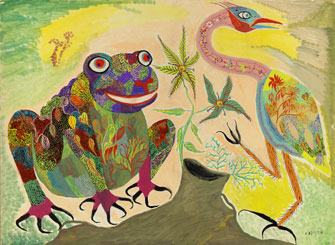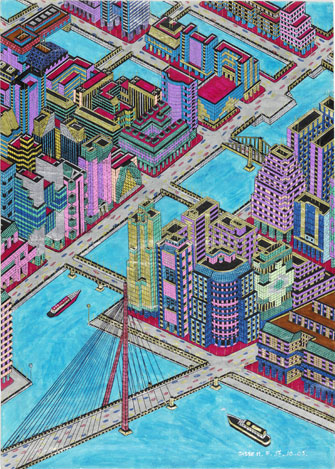Taking Folk Traditions into
The Rarefied Realm of Art

“Untitled” (1966) by Francisco da Silva © Francisco da Silva. Photo © André Morin
The exhibition “Histoires de Voir: Show and Tell” at the Fondation Cartier in Paris once again raises the sticky question of “outsider art,” a catchall phrase for art by people who work outside the mainstream art world: unschooled artists, artists with mental or physical disabilities, artists from the backwaters of the world, folk artists, etc.
This colorful, lively show, curated by Italian architect and designer Alessandro Mendini, doesn’t really take a stand on what makes outsider art different from any other art, beyond stating at the entrance that the exhibition presents work by artists usually labeled naive, primitive or self-taught and that it sets out to “examine the relationships between contemporary art and folk art, artist and artisan.”
After that, it is up to visitors to make up their minds as they wander among over 400 works by more than 40 artists, each one introduced by a large biographical panel that also provides a context for his (mostly; very few women are included) work.
Within the variety of stylistic approaches certain similarities can be seen in these works. The uninhibited use of colors would make a Fauvist green with envy, and the rules of perspective are often ignored. Animals are a popular subject, and fantasy and dream images also play an important role.
Some of the works that come out of folk traditions are curiously similar to each other although they come from worlds that are far apart. One of the standout artists in the show is Janargh Singh Shyam (whose work we have already seen in the Musée de Quai Branly’s recent exhibition “Other Masters of India”), who developed his own style based on local traditions. The fantastic, multicolored creatures he paints with dots and dashes have much in common with the paintings of Francisco da Silva from Brazil, whose work is also shown here, although the two artists are unlikely to have ever seen each other’s work.
Another of the many artists whose work I found intriguing was Mamadou Cissé, who was born in Senegal but now lives in France and

A work in pen and felt-tip pen (2005) by Mamadou Cissé. © Mamadou Cissé. Photo © André Morin.
makes intricate drawings in felt-tip pen of wildly colorful imaginary cities.
Mendini, the curator, has included some of his own works in the show, but charming as they are, they don’t really fit. The forms—a chapel, a mounted horseman and so on—are simple, but these are sophisticated, perfectly finished works covered in glass mosaics that stand out from the other works, many of which are made of rough or unconventional materials.
While many of these pieces are strongly rooted in local folk traditions, Mendini has sniffed out artists who have that extra measure of talent that lifts their work above the mass of folk art and makes it worthy of being shown in an exhibition like this.
Fondation Cartier pour l’Art Contemporain: 261, boulevard Raspail, 75014 Paris. Métro: Raspail. Tel.: 01 42 18 56 50. Open Tuesday, 11 a.m.-10 p.m.; Wednesday-Sunday, 11 a.m.-8 p.m. Admission: €9.50. Through October 21. fondation.cartier.com
Reader reaction: Click here to respond to this article (your response may be published on this page and is subject to editing).
Please support Paris Update by ordering books from Paris Update’s Amazon store at no extra cost. Click on your preferred Amazon location: U.K., France, U.S.
More reviews of Paris art shows.
© 2012 Paris Update
